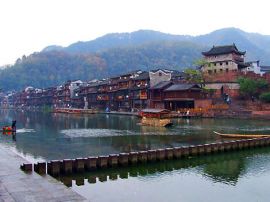Fenghuang Ancient Town
Fenghuang Ancient Town (凤凰古城), also known as Phoenix Ancient Town, located on the western edge of Hunan Province next to Guizhou, is one of the most beautiful towns in China.
With a history of 1,300 years, the town features distinct residential buildings, elegant bridges plus several mysterious towers and pagodas. Upon entering the town, visitors will immediately get a sense of the area's mystery, elegance and primitive simplicity. When an early morning mist sets in around the bridges over the water and stilted houses, the area simply becomes a mirror of traditional Chinese paintings.
Visiting a Miao village is a must when traveling in Fenghuang. Visitors will find a large array of silver ornaments, homemade tie-dyes, and unique local snacks there.
Fenghuang Ancient Town recently angered local businesspeople by introducing a fee collection policy that authorities claim is meant to better protect the town. According to the new policy effective on April 10, 2013, tourists are required to pay 148 yuan (US$23.5) to enter the town renowned for its well-preserved architecture. Prior to the policy, it was free to enter the town, but tourists were charged 148 yuan for some specific sightseeing spots and 108 yuan for a mountainous scenic spot.
Disgruntled store owners and inn keepers closed their businesses and gathered at a dock on April 11 to protest the policy, which they said would reduce their tourism revenue. Although the gathering was quickly broken up and order restored, the controversy surrounding the fee collection has been lingering, with some criticizing the local government for seeking economic gain at the cost of public interests.
Cai Long, deputy head of Fenghuang County, however, said the move was mainly aimed at raising money for the protection of the town and curbing the number of tourists. According to Cai, tourist arrivals to Fenghuang have risen to nearly 7 million annually, about 20 times the county's population. This puts great pressure on the preservation of the town's old-style architecture and long-standing tradition.
